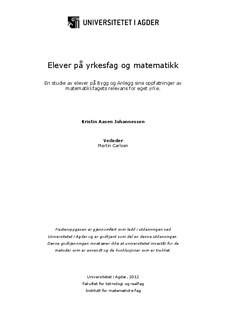| dc.contributor.author | Johannessen, Kristin Aasen | |
| dc.date.accessioned | 2012-11-08T11:39:27Z | |
| dc.date.available | 2012-11-08T11:39:27Z | |
| dc.date.issued | 2012 | |
| dc.identifier.uri | http://hdl.handle.net/11250/138110 | |
| dc.description | Masteroppgave i matematikkdidaktikk- Universitetet i Agder, 2012 | no_NO |
| dc.description.abstract | In this thesis I want to study what kind of perceptions students within the study programme ”Bygg og Anlegg” have as regards the theme mathematics and its relevance for their profession. I also want to study the mathematics teachers’ thoughts and opinions regarding this theme. My main question is: What kinds of beliefs have students and their teacher about mathematics and its relation to work. To approach this issue I have formulated the following research questions:
1. What thoughts have the students on ”Bygg og Anlegg” concerning the relevance of mathematics for their own profession?
2. What opinions does the teacher have about mathematics and work?
3. How was the teaching in mathematics carried out?
4. In what ways have curricula the last 40 years discussed and approached mathematics and its relevance to work?
My literature review focuses on students’ beliefs about mathematics and the relationships between mathematics and work are also described. Wasenden (2001) argues that it is important to relate mathematics and work because it has many benefits for the students. He thinks that the students’ interest in mathematics will increase if these relations are made clear. Lindberg and Grevholm (2011) argue in accordance with Wasenden that the students find mathematics more meaningful if they realise the connections between mathematics and the vocational subject.
The empirical material is collected in a class at a vocational school. As methods in this study I used classroom observation and semi-structured interviews. I wanted to observe three mathematics lessons to create myself a picture of the class and the teaching. These observations made it easier for me to interpret and analyse the students’ responses within the interviews. In that way I could get an impression about whether the students behaved naturally during the interview. I interviewed six students and their teacher in mathematics.
The results show that the students have some thoughts about what topics which are relevant compared with their prospective profession. The students find volume, area, Pytagoras theorem, scale and arithmetical operations as relevant topics. They realise connections between these topics and the topics which are common in both mathematics and their vocational subjects. Their teacher in mathematics finds it important to relate mathematics with the profession the students are studying. He creates tasks with work situations as context to make the connection between mathematics and work visible. The students think that these tasks made the mathematics course more interesting, because they see how they can use the mathematics in practical work situations. When the students work with these tasks they use mathematics more like a tool and the tasks become more meaningful to them.
The educational aims regarding volume and area change in the different curricula L76, R94 and LK06. In L76 the mathematics syllabus is specific and connected to the specific study programs. It is also in this curriculum that the expression yrkesrettede oppgaver and yrkesrettet matematikk are introduced. It is still a focus on relating mathematics and work in R94, but the course in mathematics is common for all study programs and the mathematics syllabus thus become more general. In LK06, the current curriculum, the issue of yrkesretting is no longer mentioned explicitly, but the curriculum rather focuses on meaningful learning in every subject. | no_NO |
| dc.language.iso | nob | no_NO |
| dc.publisher | Universitetet i Agder; University of Agder | no_NO |
| dc.subject.classification | MA 502 | |
| dc.title | Elever på yrkesfag og matematikk : en studie av elever på Bygg og Anlegg sine oppfatninger av matematikkfagets relevans for eget yrke | no_NO |
| dc.type | Master thesis | no_NO |
| dc.subject.nsi | VDP::Mathematics and natural science: 400::Mathematics: 410::Applied mathematics: 413 | no_NO |
| dc.source.pagenumber | 85 s. | no_NO |
